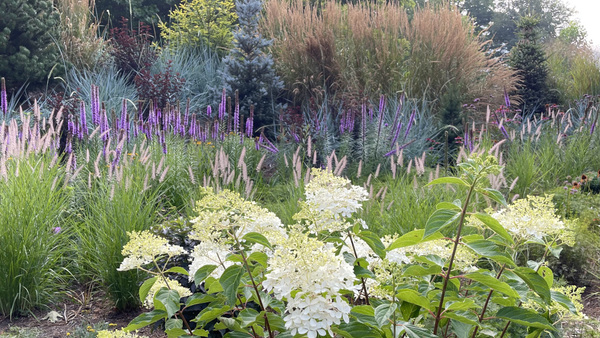
Every time I turn around, it seems there are more ornamental grasses in the landscape, and not only in gardens—some grasses have invaded the native flora as well. A friend tells a joke about this phenomenon: What do you call it when Jimmy inadvertently mows down all the Miscanthus grasses? The punch line: A good start.
However, while Miscanthus species and cultivars may be overused in the North and pampas grass (Cortaderia spp. and cvs.) is everywhere in the South, there are dozens of other highly desirable grasses. One of my favorites is feather reed grass (Calamagrostis X acutiflora), especially the one named for an exceptional German nurseryman, Karl Foerster. I’m not the only one who likes ‘Karl Foerster’; it won the big enchilada when it was named the 2001 Perennial Plant of the Year by the Perennial Plant Association. Gardeners love the plant for its handsome thin vertical green foliage from spring through fall and for its wonderful flowers, which start out pink and then change to a fine tawny color with the cool days of autumn.
‘Karl Foerster’ grows to about 18 inches wide and only about 2 to 3 feet tall, but when the flower stems are at their peak they stand nearly 5 feet tall, fluttering like butterflies in the breeze. It tolerates full sun to partial shade and any type of soil except a bog. ‘Karl Foerster’ is hardy in USDA Hardiness Zones 5 to 9, but south of Zone 7 it’s not at its best. This cool-season grass remains evergreen (actually, ever-bronze) in mild winters and works well as a screen, as a specimen, and as a container plant with other perennials or annuals. It’s sufficiently cold-hardy to overwinter in a pot in most areas.
Since this hybrid is sterile, there is virtually no chance of its escaping and becoming a scourge on the landscape. To propagate ‘Karl Foerster’, divide a single mature clump, but be prepared for a bit of a wrestling match when trying to pry offspring from a mature plant. To yield flowers the first year, divisions should have half a dozen growing points; if divisions are small they may take two years to flower. The best time to plant is in the fall; however, early-spring usually works as well. Plants can be cut back to about 6 to 9 inches in late winter or early spring.
Fine Gardening Recommended Products

Scotts Cordless Grass-Shear/Shrub-Trimmer Combo
Fine Gardening receives a commission for items purchased through links on this site, including Amazon Associates and other affiliate advertising programs.
- 13.5 x 3 x 5 inches
- Uses a 7.2-Volt 2Ah high-capacity built-in lithium-ion battery; Includes a fast charger

ARS Telescoping Long Reach Pruner
Fine Gardening receives a commission for items purchased through links on this site, including Amazon Associates and other affiliate advertising programs.

Black and Decker 22-inch Cordless Hedge Trimmer
Fine Gardening receives a commission for items purchased through links on this site, including Amazon Associates and other affiliate advertising programs.
- 38 x 7 x 7 inches
- 6.9 pounds
- 1 Lithium Ion battery required (included)


















Comments
Log in or create an account to post a comment.
Sign up Log in